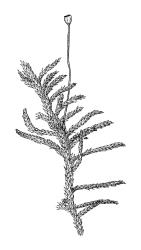No family description is presented here, as the generic description of Rhacocarpus, below, applies to the family. Crum (1994) also provided an elegant description of the family, based solely upon Rhacocarpus.
Rhacocarpus has traditionally been placed in the Hedwigiaceae, where it was placed in its own subfamily Rhacocarpoideae by Brotherus (1925). Brotherus’s placement in the Hedwigiaceae has largely been followed in subsequent Australasian literature (Dixon 1927; Sainsbury 1955; Scott & Stone 1976).
Frahm (1996) erected the genus Pararhacocarpus to accommodate the Chilean Rhacocarpus patagonicus Broth. In his publication, Frahm suggested that Pararhacocarpus was not closely allied to Rhacocarpus s.s. and indicated, partly due to its unknown sporophytes, that it should be considered of uncertain familial affinities. An isotype (CHR 4385) of Pararhacocarpus patagonicus (Broth.) J.-P.Frahm has differentiated stem and branch leaves, both unbordered, with the former distinctly plicate. The branch leaves are spirally inserted, spirally twisted around their own axes, and have extremely thick-walled and highly porose laminal cells. They also lack the lacquered dry appearance and the cuticular ornamentation characteristic of Rhacocarpus s.s. All these features suggest that P. patagonicus is correctly excluded from Rhacocarpus.
Another genus segregated from Rhacocarpus, the New Caledonian Metarhacocarpus Nog. [Journ. Hattori Bot. Lab. 58: 87, 1985], was placed in the synonymy of Dicnemon by Allen (1987).
Barthlott & Schultze-Motel (1981) examined the fine structure of the leaf surface of Rhacocarpus spp. using both scanning and transmission electron microscopy. They characterised the surface ornamentation as "a complex multi-layered reticulate and perforated wall structure resembling superficially exine stratification in tectate pollen grains. This wall character seems to be unique within the Bryophyta and emphasizes the systematically isolated position of Rhacocarpus. Functionally these structures perhaps serve as a refined ectohydric water conducting system."
De Luna (1990) demonstrated that the protonema of Rhacocarpus lacked the globular form found in the other genera placed in the Hedwigiaceae. The separation of the Rhacocarpaceae from the Hedwigiaceae was thus supported by de Luna (1995) and by Goffinet et al. (2009).
Crum’s (1994, p. 667) comments on this genus are worth quoting:
"Rhacocarpus is so distinctive in every way that it is difficult to understand why it has been included by most authors in the Hedwigiaceae, which it resembles only in lacking a costa and a peristome. The prostrate habit, pinnate branching, fiddle-shaped leaves and linear cells appearing to be densely and minutely papillose over the side walls, the strongly differentiated border, and the well-marked auricles consisting of short, dark cells with thick, porose walls demand familial recognition. The immersed position of the stomata seems especially significant in view of the rarity of immersed stomata among mosses."
Buck (1995) argued in favour of placement of Rhacocarpus close to the Dicnemonaceae in the Dicranales. He considered Rhacocarpus to be acrocarpous, but my observations on the perichaetial position in R. purpurascens do not support this.
| Category | Number |
|---|---|
| Indigenous (Non-endemic) | 1 |
| Total | 1 |




